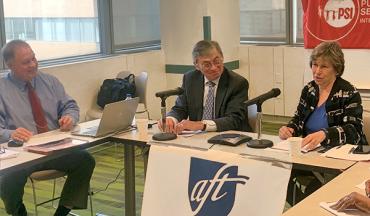While avoiding wild predictions about how many jobs will be eaten by robots, the AFT and other public sector unions are considering how to shape the future of artificial intelligence on the job.
Data is the most valuable currency right now, union leaders agreed during a Nov. 15 webinar, the first in a series of webinars on the future of jobs and the workplace. “Without data, most artificial intelligence doesn’t work,” said Daniel Bertossa, assistant general secretary for the global union federation Public Services International. Artificial intelligence already is making decisions for us, he said, from what shows up on web searches to how policymakers allocate money for public education.
Data must not be monopolized, and workers need to share in the data they create, Bertossa said, or we’ll risk widening economic inequalities and undermining democracy: “Data must be used in the public interest for the public good.”
When unions go to the bargaining table, they have to insist on understanding data processes like how job candidates or credit ratings are generated. For example, said Tom Kochan, co-director of the MIT Sloan Institute for Work and Employment Research, credit ratings are based on data that reflects the wage gap between women and men—and so perpetuates bias against women.
Similarly, procuring goods and services for public use is risky without a deep understanding of what the public needs, said Kochan, co-author of Shaping the Future of Work. You wouldn’t expect a teacher, public worker or professor to write code for a program, he said, but workers should always be in the room when employers are explaining problems or needs to a vendor.
Other dangers of digitalization include the lure of more work by fewer workers, the false promise of privatization, and the erosion of working conditions that must be addressed at the bargaining table, like the “right to disconnect.” An important goal for unions is to develop model contract language that will protect us and the people we serve. Unions can help prevent corporations and governments from unleashing advanced technologies like artificial intelligence and automated bots without proof that they serve people rather than exploit them.
AFT President Randi Weingarten offered approaches unions can take to shape the future of work. First, she said, don’t be afraid to jump into the fray. Noting that her own parents started their lives in the radio age and now are navigating the digital age, she acknowledged that the pace of change is stunning, but added: “If we don’t participate, it will be technology, not humanity, that runs our world.”
Second, she cautioned union members against allowing Silicon Valley to dictate the systems we live by. “Technology has to supplement, not supplant, our lives,” she said. Workers must be involved in designing technology on the front end, shaping how it functions and using collective bargaining to address the conditions this new work brings.
Education and training in new technology are critical, said Eckhard Voss, co-author of a PSI study on digitalization and public services from a labor perspective. Weingarten noted that research like PSI’s is essential to prove that involving workers in tech design really is in the public interest.
Flexing our union muscle
Together through our unions, the speakers agreed, we can use our voice at work to build a better life for everyone. We can demand access to local data, pressure political leaders to evaluate the effects of change, and renegotiate our contracts if the terms are wrong or if situations have changed. We should make conversations on artificial intelligence available to as many people as possible. We should engage specialists to teach our frontline workers, and we should make sure teachers are enabled to educate the world’s future scientists, managers and engineers.
Change isn’t easy, Weingarten said, but we need to “use our power, expertise and care to navigate change and make sure no one is left behind.”
You can view the webinar here.
[Annette Licitra]


